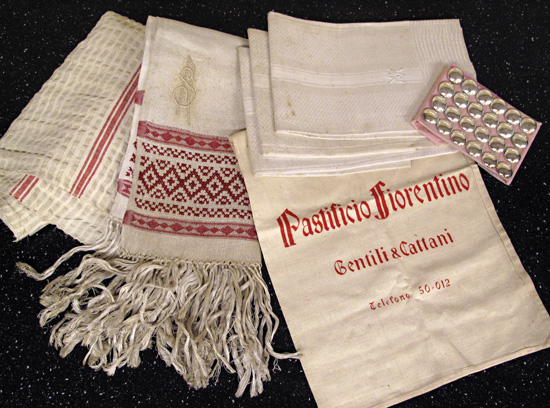
by Maureen | Mar 30, 2010 | Discoveries, Featured Articles, Firenze, Incredible Locations, Journal, Photos, Shopping & Markets
It was as a Camp Fire Girl in fifth grade that I learned to sew by stitching along the lines of binder paper. I’ve been sewing by machine and by hand ever since and fabric is one of the things that makes my heart rate pick up. (Literally.) So, put me in a place where I can find antique fabric, handwork and sewing “notions” and I think I’ve gone to heaven. I passed up some red-on-white cross-stitch samplers from the late 1800s either because they weren’t well-wrought, or the price was higher than I was willing to spring for. I did bring home this little bundle which I will wash up and actually use: embroidered hand towels and napkins, sterling buttons and a muslin flour sack. (I’m easily amused.)

Can you believe I found MY initials embroidered?!
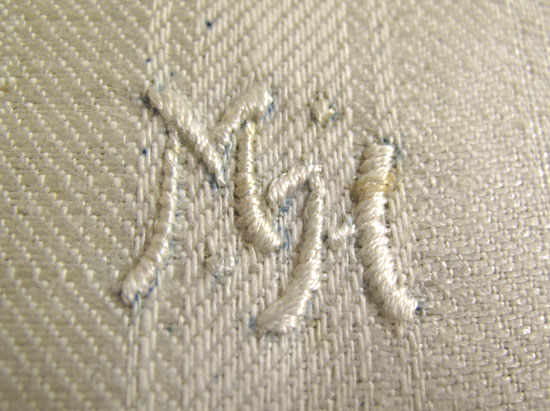
There was a box of about 10 dozen sterling silver buttons produced for Italian military uniforms. Each is marked with “Milano” on the back, which I think is more beautiful than the high-polish front. (I’ll take steel wool to the surface to rough them up, then use them on a special jacket I’ll make.)
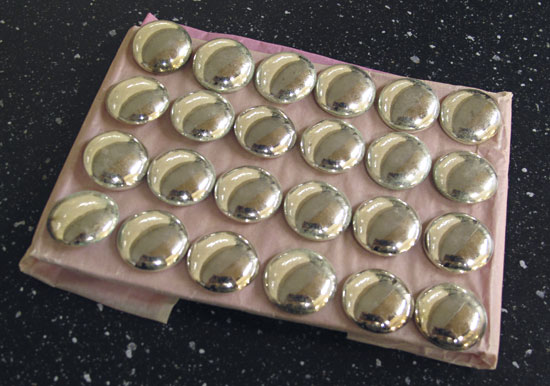
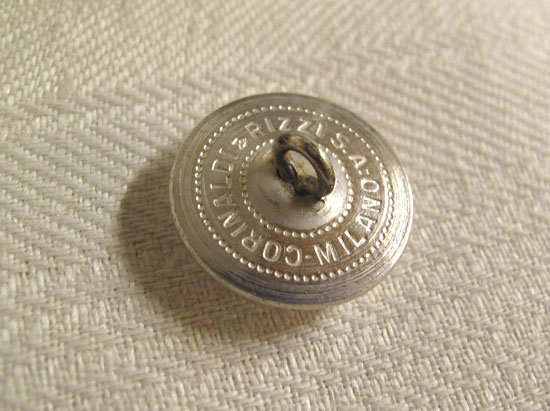
This is elaborate raised stitching on the damask, woven patten.
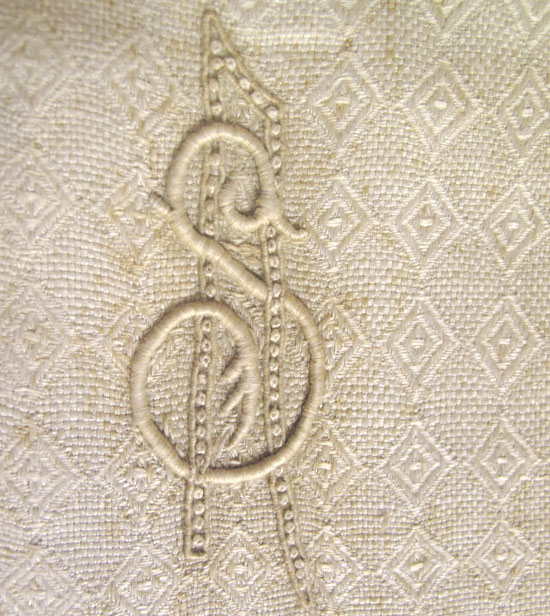
This fringed towel features hand-wrought, counted cross-stitch in between two woven borders.
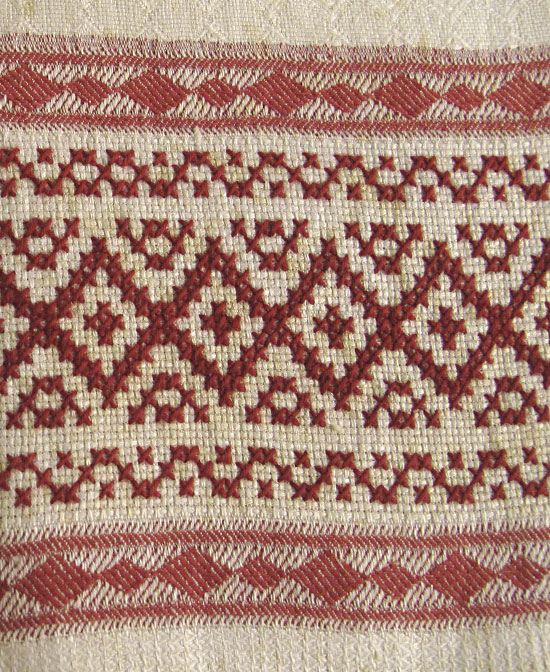
This was a sign on the door of a little shop where they do “polishing, lacquering, restoration and gilding” and sell antique furniture and frames. “Excuse me, would you be willing to sell your sign?”
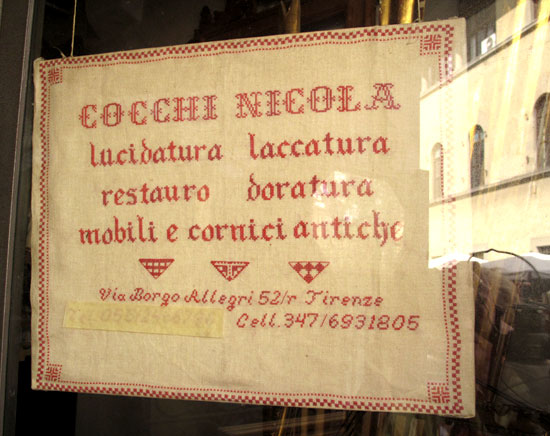
The sellers of this piece were out to lunch. I waited around but they didn’t return, so I simply photographed it. This is a religious symbol for Mary, Mother of God. The “AM” monogram stands for “Ave Maria”. I’ve seen this symbol other places in Italy, such as the cathedral in San Giovanni Valdarno when I was there 2 years ago.
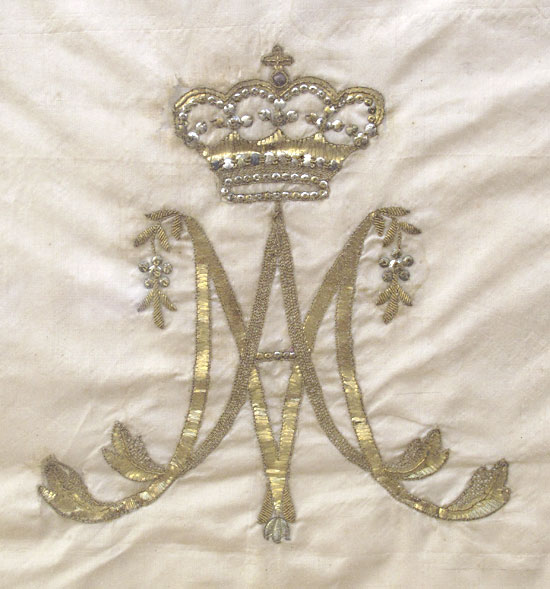
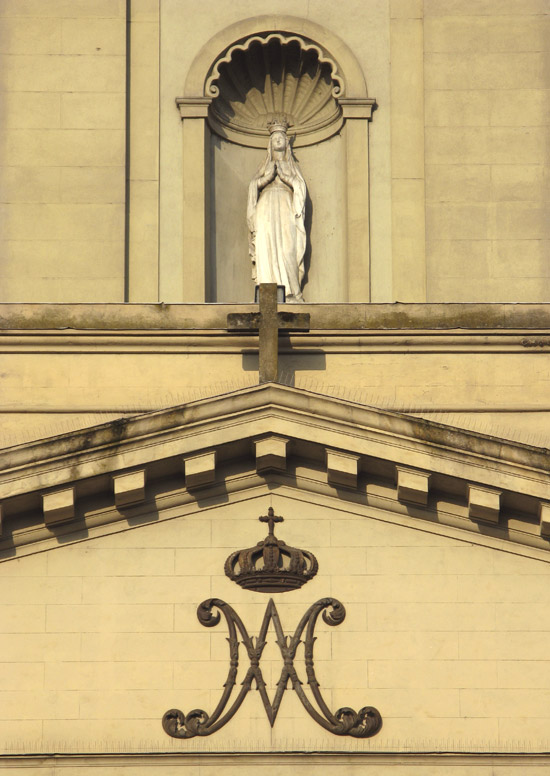
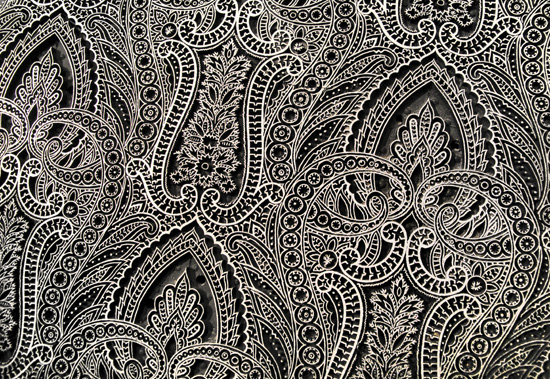
by Maureen | Mar 17, 2010 | Discoveries, Featured Articles, Graphics, Journal, Photo of the Day, Photos
When here in Milano in the summer of 2008, I stumbled upon a Zucchi Store just a half block north of the Duomo. They sell lovely household linens (sheets and towels) and they had a curious display in the window. I didn’t understand what I was seeing, so I had to go in.
Emerging up through a very large, circular hole in the first floor was a towering stack of flat wooden blocks. What were the blocks? It was then that I found out about the Zucchi Collection of wood-and-pewter blocks for printing fabric.
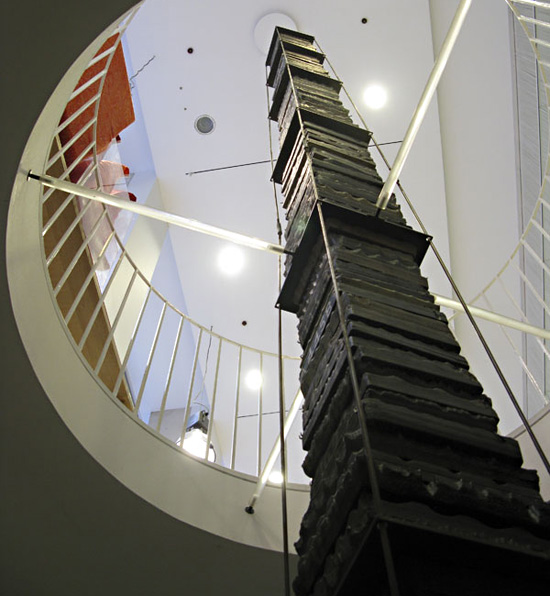
From the Zucchi Website: “The Collection’s 12,000 designs bear witness, over a period which spans three centuries from 1785 to 1935, to a fashion that was both varied and popular. Such tastes were apparent during one of the most energetic and fertile periods of European culture, which ended with the first stylistic experiments of the Art Nouveau and Art Deco movements.
“The Collection houses 56,000 printing blocks, an extraordinary number by any reckoning and one which presents concrete problems not only of space but also of storage in structures able to support the weight of many tonnes. The Collection is housed in three different storage locations: the Zucchi office in Casorezzo, the Via Foscolo location in Milan and a warehouse in Ossona.
“To make the Collection accessible not only to scholars but also to the fashion people, it was necessary to choose criteria by which the artefacts could be subdivided. The Zucchi Collection has been divided into six categories, which are identified in terms of iconographic forms: abstract, cashmere, floral, geometric, ornamental and pictorial. The Collection has been further subdivided according to the specific uses not only for the borders of the materials but also for foulards, bandanas, various ties, scarves and cravats, etc. A special data card, in computerised and paper formats, has been assigned to every series of blocks. Each of these contains various items of information about the handblock concerned, including the number of pieces which make up the structure, the design style it is capable of reproducing, its historical period and its origins. Attention has also been given to the question of conserving these structures and rightly so because the wood is sensitive material. The humidity and temperature levels require strict control and beeswax and turpentine must be applied to maintain the elasticity of the wood.”
A mere fraction of the collection has been on display on the lower floor of the Zucchi Store, including floor-to-ceiling, wall-to-wall shelves holding the numbered wood blocks. (They are now in the process of moving these blocks to another location.) Note that some designs have 3-5 different blocks to create the full design. (They are all numbered alike.) Being a lover of textiles I was immediately enamored of the collection.
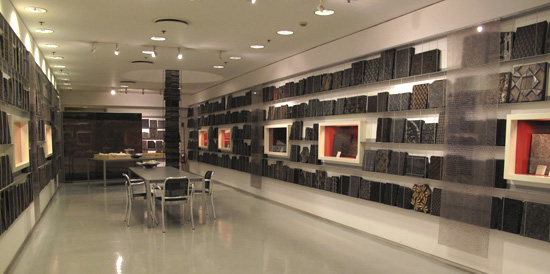
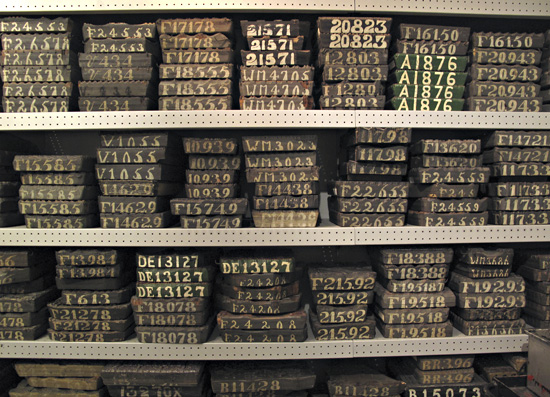
Fast-forward almost 2 years and now I’m living in Milano. Last Fall I found a curious and creative textile studio not far away named “L’Hub” on the Naviglio Grande, the “big” canal. One, they were selling vintage Zucchi linen and cotton dishtowels from the mid- and late-1900s. (Yes. I bought a bunch.) Two, they offer all sorts of creative textile classes including dyeing, sewing, construction, AND printing fabric with the centuries-old Zucchi blocks! Can you say “Sign me up!”?
I enrolled in the 3-hour class held last Saturday afternoon, taught by artist Franco Duranti (at the very far left in the next photo). Among other things, Franco is a painter, engraver, and video artist AND since 2007, he’s been creating original works with the Zucchi wood blocks! Below is a photo of the working studio at L’Hub. Some women were taking a sewing class, while two other women were also taking the fabric stamping class.
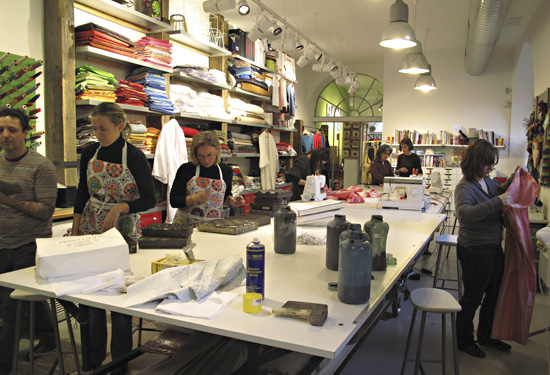
I wanted “classic”. I had just seen the Frette Textile Exhibit a week ago. I’m enthralled by the traditional fabric handwork of generations past and am especially inspired by my Great Great Grandmother’s work, done at age 12 in 1861. She crafted a cross-stitch sampler in “Turkey Red” on cream-colored cloth, and that color combination has launched me ever since my Grandmother gave me the sampler in 1975.
On the neighboring streets (on that recent day when I was getting snowflakes in my eyes) I scouted fabric stores and came away with Italian, 100% Linen. I bought a meter of fabric and took it home to prewash.
In familiarizing myself with the printing process, I chose a simple fleur-de-lis pattern printed in “carminio” – carmine red – on the linen. Note how, in this case, the block carries an “island” of cast pewter attached to the wood,
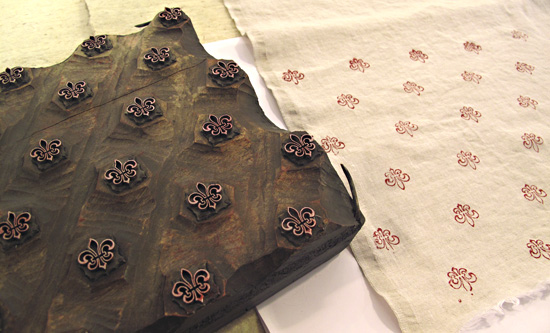
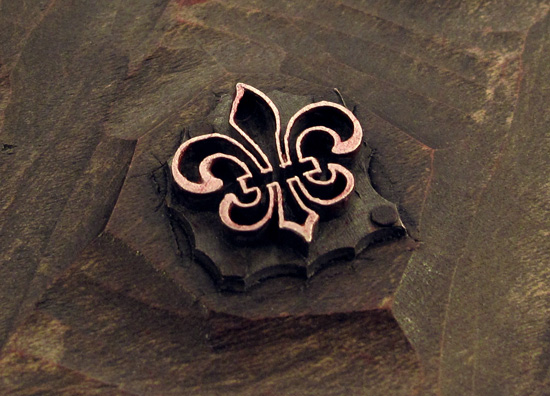
The following is an intricate, cast-pewter, paisley design from the “Cashmere” group of blocks in the collection. THIS makes my heart melt! Unfortunately, I was not able to print with this block, but printed with one I found that was as close as possible.

In gathering fabric for printing, I had also gone BACK to the Zucchi store downtown and they just happened to be having a sale! I bought two sets of sheets. One set is 100% cotton, satin finish with a subtle, printed khaki/cream pattern. I printed right over the top of the pattern to create a set of sheets like no other in the world.
I also paid a visit to the second-hand store 2 blocks away. I found white, cotton button-end pillowcases and bought all six at 2 euro each (about $2.75) When I got them home to wash them, I looked inside and noticed a… Zucchi label! Of course.
My plan now is to return to the L’Hub studio for a solo 3-hour stint to embellish the pieces I began, and to print even more.
As I wallow in Art and Design during my time here in Italy, I can’t imagine a more exhilarating addition to my list of design experiences than printing with the Zucchi handblocks at L’Hub!
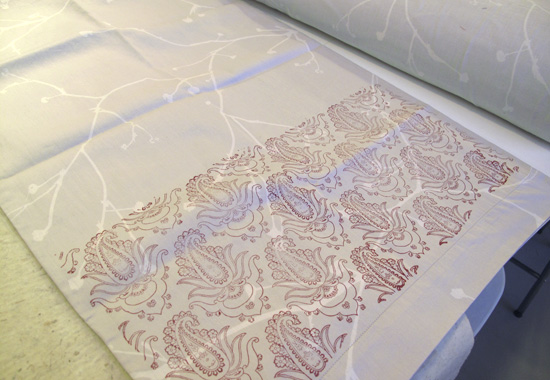
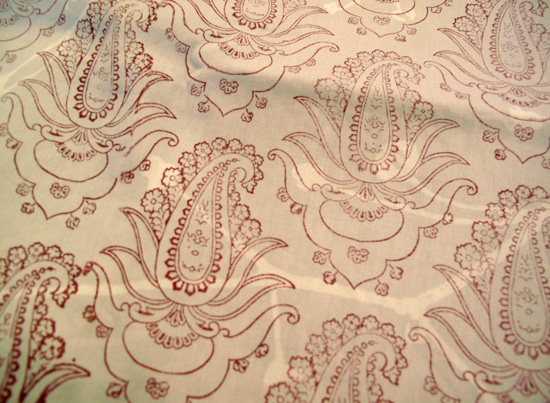
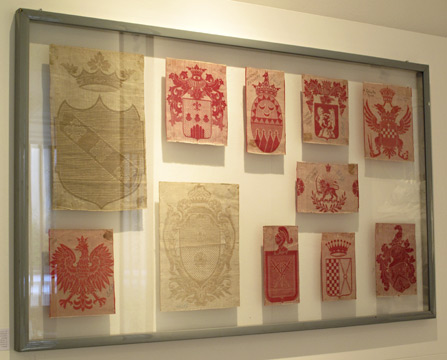
by Maureen | Mar 8, 2010 | Discoveries, Featured Articles, Graphics, Journal, Photos
When I rounded the corner and saw the wall of red and cream damask patterns, I skipped both a breath and a heart beat. These are the textiles I came for. These are the fabrics I prowl and lurk for at the antique fairs.
“The Thread of Dreams – Il Filo dei Sogni” is a show at the Palazzo Morando Costume Moda Immagine here in Milano. The show marks the 150 years of the Frette Linens company, 1860-2010. Absolutely gorgeous damask/jacquard patterns from the time of Frette’s beginning were gathered on a heart-stopping wall. I swooned. And then turned and strolled to look at them all.
Having been a seamstress for as long as I can remember, my heart rate really does pick up a few beats when in the presence of beautiful fabric. And, owning a red-on-cream embroidered piece from my great, great grandmother that she stitched at age 12 in 1861, I have a tremendous soft spot for that color combination. Combine those two joys and of course it was dreamlike for me to see this show!
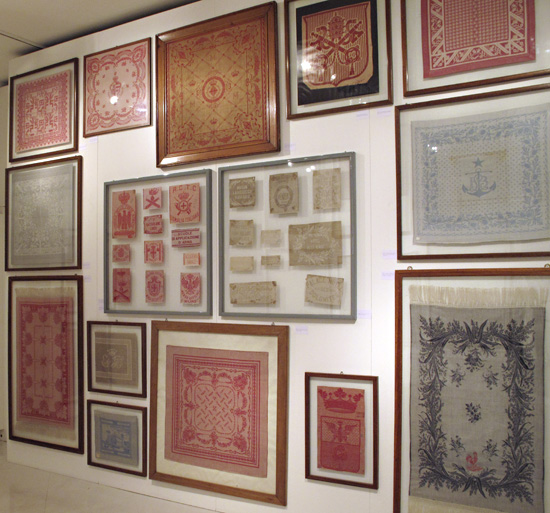
Original hand-painted and hand-drawn designs were shown side-by-side with the final woven fabric. A pleasure to see “the hand” of the designer. (And impossible to avoid glare and reflection in the exhibit space!)
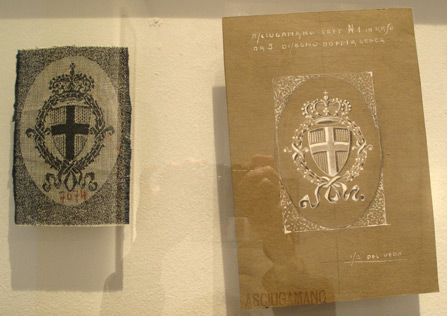

They showed overall patterns, borders, coats-of-arms, hotel emblems, nautical, floral and heraldic designs. If I were to bring home any “souvenir” from Italy, I would love to get my hands on one of these Frette fabrics, either vintage or modern day!
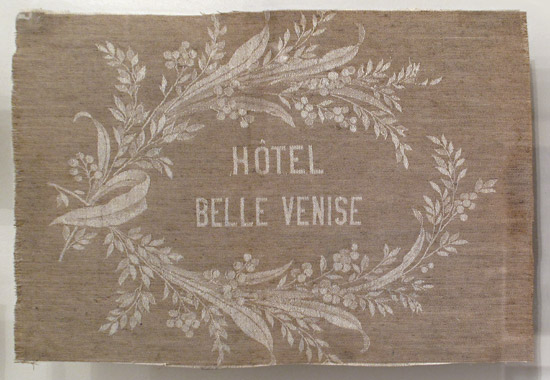
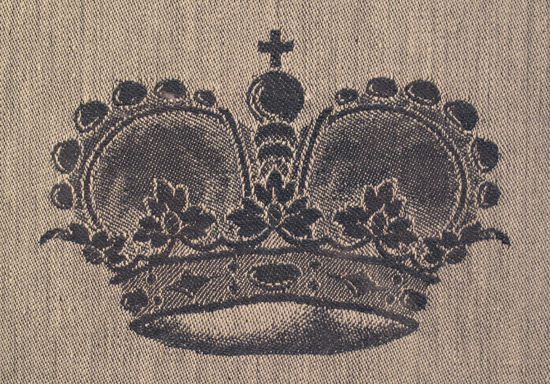
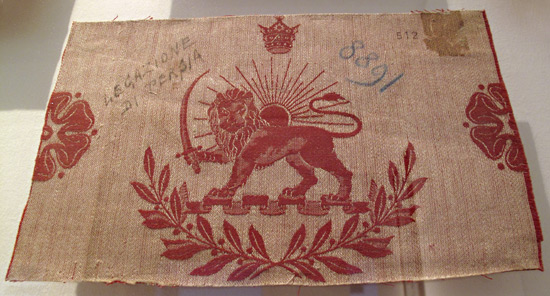
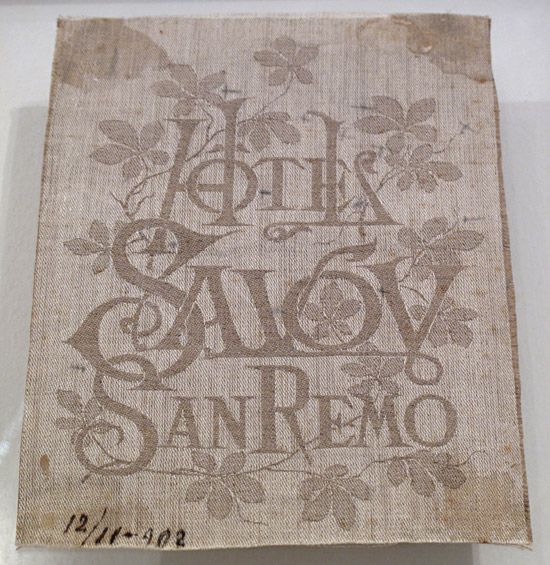
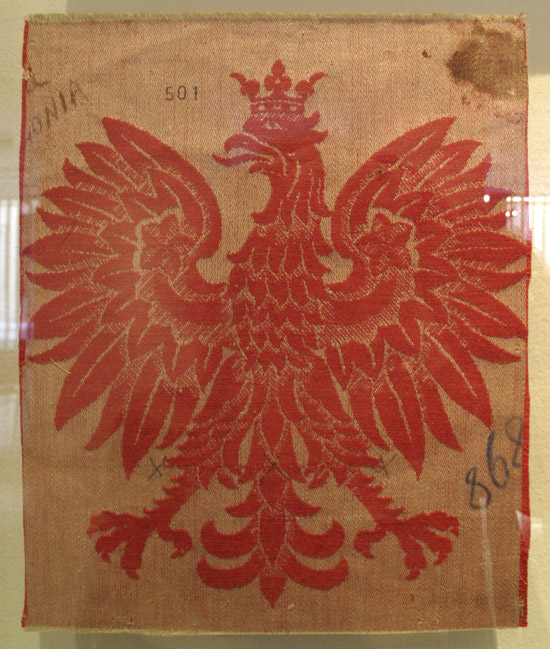
Why fight the reflection? Here’s a Frette self-portrait. (My sister is always saying “I want to see pictures of YOU over there,” so this is my way of complying with her request.)
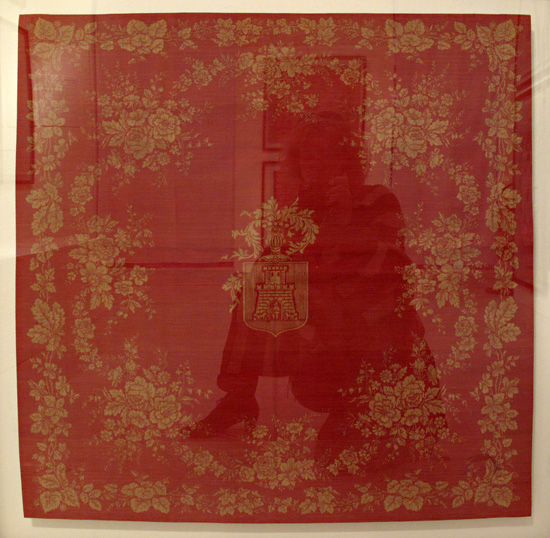
Currently, Frette is known for their very sumptuous bed linens. Ooo lah lah. A damask top sheet alone can be $250 or more and the fabric is supple and luxurious to the touch.
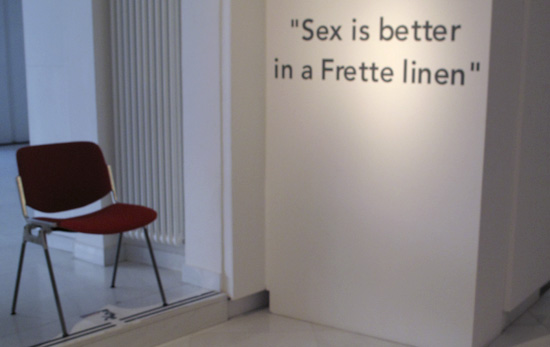
Part of the exhibit was a “mood wall” showing ideas, sketches, fabric samples and inspirations for a contemporary collection. I appreciate that they show original pencil drawings and a variety of renditions of a given motif all the way to the final fabric.
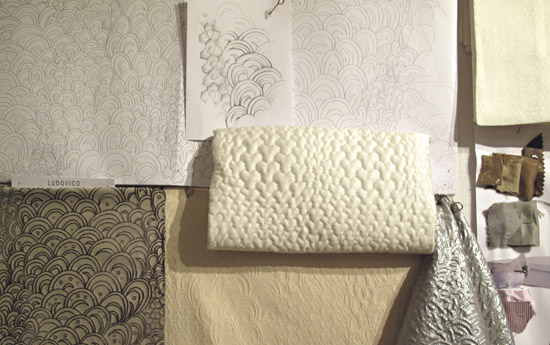
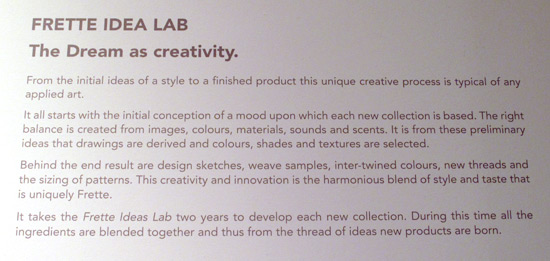
Another part of the show was an amusing, playful sculptural installation in an homage to Frette. I delighted in it as I walked into the room and circled.
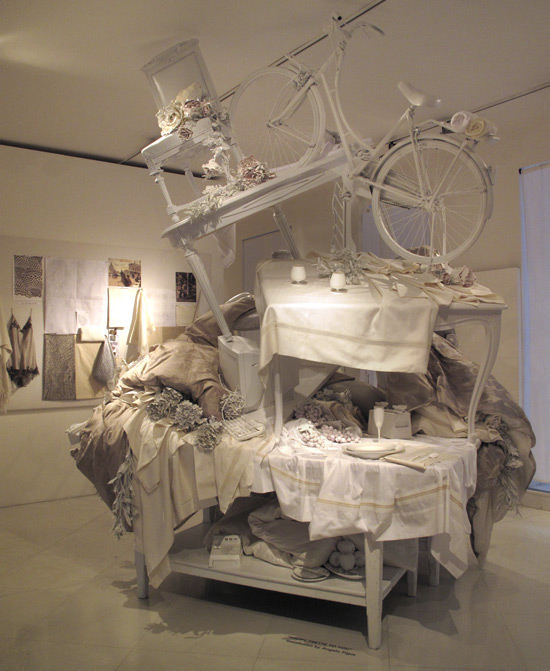
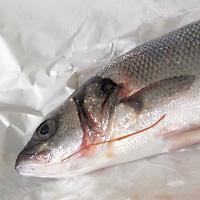
by Maureen | Oct 11, 2009 | Canals, Featured Articles, Journal, Meals, Shopping & Markets
Nope. It’s not a Vespa-type scooter or a little car. It’s a little fish.

A couple of months ago, while at the Saturday market, I was overwhelmed by the seafood choices I had no familiarity with. No halibut, salmon or rock cod here. There was fish I knew nothing about except for a couple I had ordered from menus: orata and branzino. “But what do I do with it?” Besides. I had neither a filet knife nor knife sharpener, so I was ill-prepared.
Having just returned from a visit to Seattle this week, (filet knife and EZE-Lap sharpener in hand), hankerin’ for fish*, and doing a “fast stroll” near the Naviglio Grande (the big canal) I found a street-side fish market in my path. “Uno branzino”, I said to the guy. He wrapped it up. I paid 4 Euro, 6 bucks. I threw it in my bag and went on to shop for fabric. (Fabric and fish in the same bag? Hmm.)
(*By the way, can one ” have a hankerin’ ” in Italy. I’m not sure the translation works.)
Saturday evening. Canal-side. The place was lively with people strolling at a slow pace. Here I was, trying to keep my usual 4.5 mile-per-hour Indian Trail pace. (Fat chance, Maureen. Take it easy! Relax for once.) Maybe that’s something Italy will teach me: how to stroll properly, without being “on a mission”.
At 7:00, I stepped into the little fabric store NOT like those in the U.S.! Dark, jammed floor-to-ceiling, wall-to-wall, and much of it had probably been there a long time. I was looking for, and found, fabric for a baby quilt. (Just try buying quilting supplies in Italian!) I left moments before they closed at 7:30.
It was the first time in 4 months I had gone out in public wearing blue jeans (!) and tennis shoes (not quite blinding white). I had been cleaning all day and felt like being comfy. At 8:00 in the evening, sleeveless, it was muggy enough that I was working up a sticky sweat. (All the more reason to slow down.) Most everyone else was either paired up or on-the-make, so blue jeans and tennis shoes never entered their minds, I’m sure!
Meanwhile, I had a scantily-wrapped branzino in my bag with baby quilt fabric, so I figured I’d better hustle to the grocery store, buy whatever else I needed, and get home and cook!
I hadn’t noticed at the fish stall that the fish had not been gutted. No problem. I’ve gutted many a fish in my day. And I found out that branzino, (which is actually a European Seabass), has a pretty wicked, spiny dorsal fin! A pair of scissors made short work of those half dozen thorns.
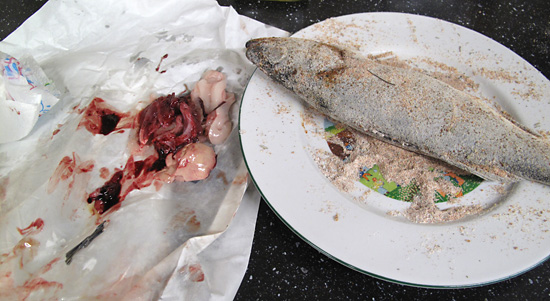
Based on it’s size, roughly 11″ stem-to-stern, I figured I could cook a branzino much like a nice-sized rainbow trout. Flour, salt, pepper, mixed herbs…and since I had just been in Seattle, I threw in some of Chef Tom Douglas’ Salmon Rub (Brown Sugar, Paprika and thyme). A little extra virgin in my new grill pan, crank up the heat and throw on the fish. Veggies searing in the pan next door promised a lovely dinner.
(By the way, note the pan in the upper left. I’ve boiled water for coffee twice and that’s the amount of white, calcium build-up that occurs! I have to scrub the pan hard every day.)
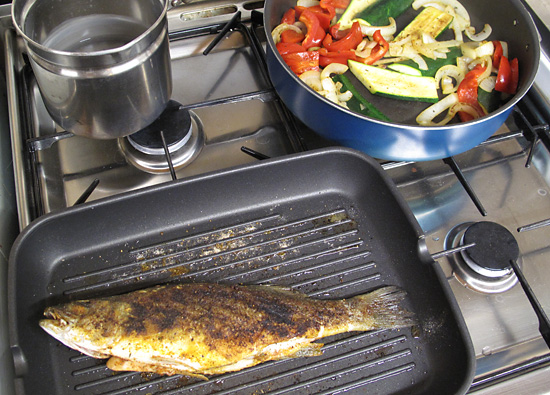
Ahh. The smell of fish cooking with oil. One would think it’s a good time to open the windows, especially on a muggy night! No way! I wouldn’t sleep all night; the mosquitos would eat me alive. I opted for the fishy smell and a good night’s sleep.
“Mr. Branzino” cooked for about 20 minutes or so. Perfection. A glass of Grillo from Sicilia, a couple slices of cornmeal bread and at 9:30 I was ready to eat. Note that the branzino is served up right alongside my Mac, my updated to-do list, the utility bill from the landlady, a job ticket, trip receipts and hardware warranty info.
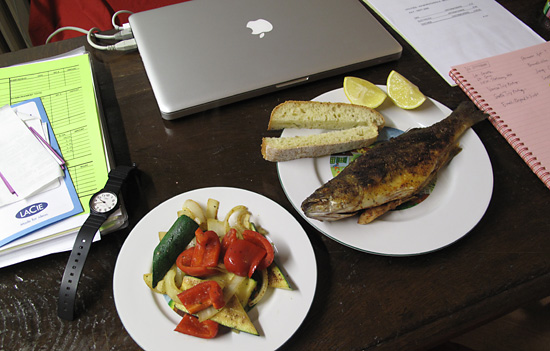
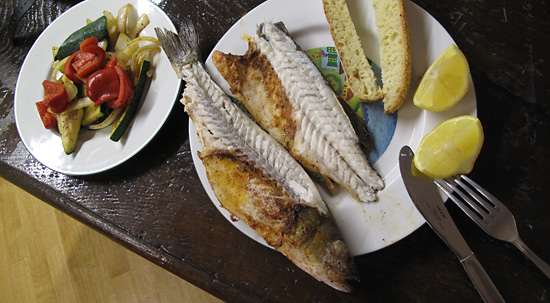
Delicately flavored. White. Moist. Cooked perfectly. Mmm. In trout fashion, I lifted the tail and peeled the spine and upper half away from the lower. I didn’t eat the skin because trying to scale the fish earlier had been making more of a mess than necessary, so I simply lifted the fish flakes away from the skin and gobbled them. Then I flipped the other half, easily lifted the skeleton and enjoyed the rest of the fish. What a delicious meal!
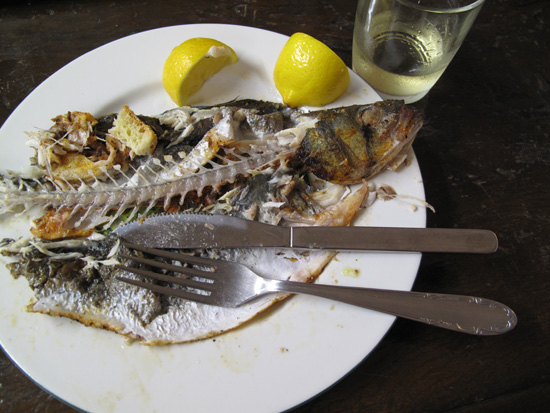
FROM WIKIPEDIA:
The European seabass, Dicentrarchus labrax, also known as Morone labrax, is a primarily ocean-going fish that sometimes enters brackish and fresh water. It is also known as the sea dace. As a food fish, it is often marketed as mediterranean seabass, bronzini or branzini(“branzino” is the name of the fish in Northern Italy; in other parts of the country it is called “spigola” or “ragno”). In Spain, it is called “lubina”. It has silver sides and a white belly. Juvenile fish maintain black spots on the back and sides, a feature that can create confusion with Dicentrarchus punctatus. This fish’s operculum is serrated and spined. It can grow to a total length of over 1 m (3.3 ft) and 15 kg of weight.
Its habitats include estuaries, lagoons, coastal waters and rivers. It is found in the waters in and around Europe, including the eastern Atlantic Ocean (from Norway to Senegal), the Mediterranean Sea and the Black Sea.
It is mostly a night hunter, feeding on small fish, polychaetes, cephalopods and crustaceans.
The fish has come under increasing pressure from commercial fishing and has recently become the focus in the United Kingdom of a conservation effort by recreational anglers. In Italy the seabass is subject of intensive breeding in salt waters.
by Maureen | Jul 9, 2009 | Introspection, Journal, Quips
Sabato 4 luglio • Saturday, July 4
Journal Entry
Wandering Via Monte Napoleone… How will I survive here without my sewing machine? I might BURST! Jil Sander and Kenzo have such details. Insets. Glorious fine fabrics. Combinations. Sander is pared. Kenzo is playful. And they both do it damn well. I tour Milano with my fingertips, taking in every contrast in fiber, weave, knit. Exquisite. My dream of such fabric. I’d love to “go underground”, into seclusion with a good machine and just a fraction of the material I encounter here. I wouldn’t even know how to handle it (the fabric)… but give me a chance to try!
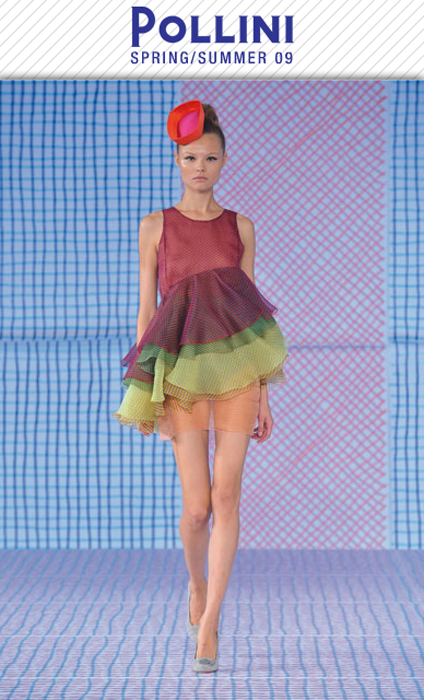
by Maureen | Jun 19, 2009 | Discoveries, Quips
OK. I just had to try it on. I was walking right across from the duomo in what is probably one of the world’s most expensive shopping districts, surrounding the Galleria, and my head whipped around when I caught sight of the fabric of this dress. It pulled me into the store, Pollini.
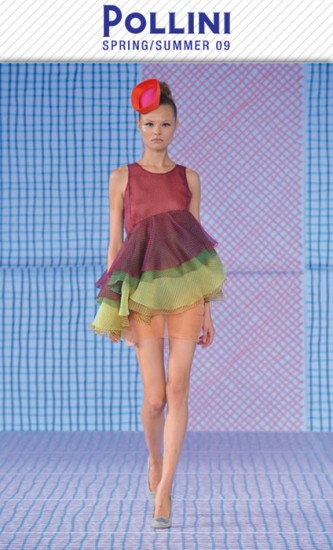
Pollini Dress
I walked up to the dress, pulled it off the rack and kept smiling. The fabric was a VERY sheer, somewhat stiff-bodied chiffon and it was constructed in layer-upon-layer of bias-cut, undulating ruffles. Each layer was a different stripe or polka dot in primary and secondary colors.
Wild. I kept smiling, the dress amused me. I twirled the dress on the hanger, just to see how the fabric moved. It was a visual feast. So much fun.
The woman at the store nudged me to try it on, so I finally gave in, (though never intending to buy it). It wasn’t the price tag (780 Euro or about $1100), but more that it wasn’t my kind of dress to wear. (It also didn’t fit me like it does the model in the photo!) It’s the kind of dress I’d hang on the wall just to please my eyes. It would be great art. (Too bad this photo, from their web site, doesn’t allow you to see the fabric patterns.)
I looked at the other clothes in the store and enjoyed the layering that they’ve integrated into the other garments. Sometimes an asymmetrical collar or skirt wrap.
One thing about Italian clothing is the sumptuousness of the fabric! Having been a seamstress for 40 years, beautiful fabric with a “good hand” makes me swoon. I can’t even FIND fabric like that in Seattle. As meticulous as I am, I don’t know whether I’d be able to work with fabric of that quality. The threads are so fine and so “buttery soft” that it would take extreme finesse to work with it, much like a slippery silk.
But, Oh!, to TOUCH that fabric makes my heart beat faster!









































